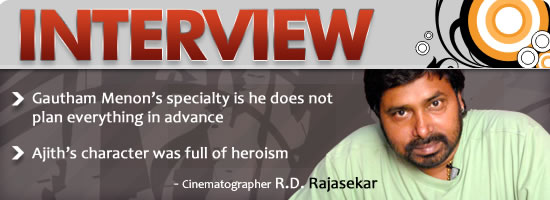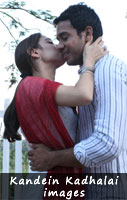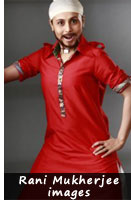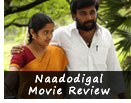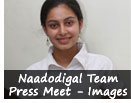| |
|
|
| |
|
|
Interviewer:
Daya | Camera: Hemananth.B & P.Ganesh
Babu | Text: Daya
|
|
R.D.
Rajasekar is one of the best cinematographers
in Kollywood and his youthful and
peppy camerawork has helped enhance
the visual beauty of many films. A
gold medalist in D.F.T., he has worked
for over 14 films including block
busters like Kaakka Kaakka, Ghajini
and Manmadan that were landmarks in
Tamil cinema.
He made his debut with Minnale, the
youthful romance that proved a hit
but it was Kaaka Kaakka that firmly
established his style. It also won
him the Film Fare Award for the Best
Cinematographer (South India) and
the Best Cinematographer at the Asian
First Film Festival. He has scooped
up many awards and accolades since
then. However, what keeps him going
is his unquenchable passion for films
and desire to keep experimenting.
Join us as we catch up with him. |
|
|
|
BW: What inspired you
to enter the film industry?
Why did you choose cinematography?
R.D.
Rajasekar: I studied
B Sc Zoology in Government College,
Kumbakonam and lived at Mayavaram,
about 12 kms away. I traveled
by train everyday from home
and back. There was a theatre
close to the college and this
is where my friends and I would
hangout after college till 4.30,
5 but we can never watch a film
till the end as our train bound
for home would start around
the same time. Hence were forced
to leave at the end of the film
just before the climax. So,
I have never seen the endings
of many films and would write
my own climax and later check
with my friends if that was
correct. On many occasions,
I was thrilled that what I had
written the exactly the way
the film ended. So I thought
to myself, why not try making
a film.
|
I asked one of my friends
how to get into cinema
and he told me that there
were two film institutes,
one in Pune and one in
Chennai. I applied for
both but that year I did
not get any response.
Then I joined Marine Biology
in Anna University and
again applied for both
direction and cinematography
at the film institute
in Chennai. I received
an interview call for
both and at the same time
2.30 p.m. I was in a dilemma
and approached a professor
for advice and he gave
me a beautiful reply that
was a turning point for
me. He said if you learn
direction, you can never
learn cinematography.
Direction is a total aesthetic
sense. Cinematography
is a total technical sense.
If you learn cinematography,
later you can easily learn
direction because that
is aesthetic. You write,
tune and express what
you feel. |
"
I have
never
seen the
endings of
many
films "
|
|
"
I did not have
any
kind of
recommendation
"
|
What is your experience
working under Rajeev Menon?
Meeting
Rajeev Menon the first
time was a memorable experience.
After I completed college,
I realized that I needed
to work under a good cinematographer
to learn more. I made
a list of the best cinematographers
and Rajeev topped the
list. I did not have any
kind of recommendation;
I just went straight to
his house in the morning
around 5.30. He had just
returned from jogging
and opened the door himself.
He was eating sandwiches
and offered me some without
even knowing me. I learnt
hospitality from him.
|
|
He asked me if I had studied at
the film institute and hearing
me he said, “I have two
departments- feature films and
commercials, which one would you
choose?” I told him I want
to learn commercials and later
do feature films. He seemed pleased
with my answer and asked me to
come the next day. I went on to
work with him for 8 years. It
was a like a Gurukulam.
The best part of the training
was that when it came to making
ad films right from the synopsis,
discussion, music, location hunting,
scripting to post-production,
every member of the team had to
be capable of doing everything.
So from cinematography to direction,
you learn every area. If I can
shoot in any area confidently,
it’s something I learnt
form Rajeev Sir.
How did you get your first break?
My first film was Minnale. Gautham
and I were working for Rajeev
and at that point he was much
junior. He had just completed
his engineering and had joined
as an assistant director in
Minsara Kanavu and was very
brilliant. One day we were working
and had a casual conversation
about work. He shared the story
of Minnale with me and asked
for my opinion. I asked him
to write it as a screenplay
and he did this in a few days
and I felt it was good. He wanted
to cast a new face but I asked
him to try Madhavan who had
just finished Alaipayudey. I
told him not to go through any
PRO but approach him directly.
He called Madhavan and narrated
the script and they became friends.
A beautiful thing in the film
was Harris Jayaraj who used
to do music for many commercials
for me. I told Gautham about
him and said we can form a new
team and asked him to meet him.
They met and the rest is history.
Harris’s beautiful music
made the film bloom. The film
inspired youth and was much
appreciated.
Besides feature films, you have
completed many ad films. What
is the difference you find working
with both mediums?
In
a feature film, whatever you
do, once it’s done, you
get recognition. You also have
a love for the film which will
be with you throughout the film,
from the first frame to the
final. You have the sense of
ownership that this is our film
and we must do things well and
incorporate elements that will
get audience appreciation. For
an ad film, you emphasize product
features and after you shoot,
the film when released gets
over in 30 seconds, Besides
its life is short. However,
a feature film is shot on film
and has a long life. I love
feature films more.
You have worked on three films
with director Gautham Menon. What
has been your experience with
him?
|
|
He believes that film
making should be simple.
He does not want anything
to look hard; he wants
it to look realistic and
youthful. I have worked
in Minnale, Kaakka Kaakka
and Gharshana and all
three were big hits that
inspired everyone. Gautham
Menon’s specialty
is he does not plan everything
in advance. When he reaches
the sets, he looks at
the situation and then
plans. This makes everything
feel natural. He adapts
to the location and sometimes
writes in beautiful things
on the spot which I find
is very positive for his
films. He is a writer,
he writes the script completely
and then stops thinking
about it. The process
of making the film is
team work. It’s
done after discussion
with the cameraman, editor
in a friendly approach.
He is not set in his ideas
but allows scope for the
work to |
"
Gautham Menon’s
specialty is
he
does not plan
everything
in advance "
|
|
develop. This is very sportive
of him and I really like it.
That’s why his films are
natural and realistic, it’s
the team work. His films with
Harris Jayaraj have been hits
because he devotes attention
to music. He is not adamant
that the music should turn out
only in a particular way but
allows freedom.
Tell us about Harris Jayaraj?
Has his work inspired you?
Definitely!
After listening to all his songs
in Kaakka Kaakka I was immensely
inspired. There is a travel
song (Ennai Konjam) which is
a beautiful piece which I was
inspired to picturise in the
jeep after listening to it.
Suriya and Jo in their youthful
exuberance was a plus for the
film.
You have worked with Suriya
in many films. Tell us something
about him.
|
"
When Suriya
listens
to the script,
he stays silent "
|
I have worked with Suriya
in Kaakka Kaakka, Ghajini
and Sillunu Oru Kaadal.
Kaakka Kaakka and Ghajini
brought me a lot of recognition
and Sillunu Oru Kaadal
is a film I really liked.
When Suriya listens to
the script, he stays silent.
However, once he gets
into the script he gets
completely involved. He
continually keeps thinking
of how he can perform
the character from the
first frame to the last.
He would ask for takes
until he was satisfied
and would get into the
skin of the character.
He is a great artiste. |
|
What is your experience with
other stars like Ajith and Vikram?
Do you do anything in particular
to suit their image?
|
My first break after Minnale
was a song called Pookkaraa
with Ajith. Ravi K Chandran
was the cameraman. We
shot the song and after
completion, Ajith called
me to find out what I
was doing. I told him
I was searching for a
job. He said he will call
me in four days and will
do a film with me. As
promised he called and
told he was starting work
on a film called Red and
that I was the cameraman.
Though the film did not
do well commercially,
Ajith’s character
was full of heroism and
I created a special backlight
for him. Like a don, I
maintained this for him
right from the first to
the last frame. He liked
this very much and I liked
the film. |
"
Ajith’s character
was
full of heroism "
|
|
I worked with Vikram in Bheema.
The film was very stylized and,
subtle. Vikram had to have a
specific look and I worked a
lot on his look enhancing the
impact of his performance. Bheema
experience was superb and I
may do his next film too.
All your films are commercials.
Is this a conscious decision?
Film is a commercial media.
For a cameraman to get a good
break, the subject must be hero-based
so that the budget will be big.
The films that came to me were
like that and it is only natural
they had to be commercial to
reach everyone. It’s also
important that the film is good.
There is nothing like I don’t
want to do an offbeat film.
The circumstances have not worked
out.
How would you define your style?
Once a graphic designer told
me that all my shots move like
a plus mark. I keep the monitor
in mind and plan the shot well.
My strong area is operation.
When I pan from the first to
last frame I want the composition
to be correct, even in the intermittent
frames.
One school of thought says that
a cinematographer should not
have a distinct recognizable
style but rather his work should
go along with the script. What
do you think?
Each film has a particular kind
of script and you do need cinematography
that will suit the script. However,
I feel it needs to bring my
work recognition; otherwise
it is of no use. I have to do
something that shows my style.
When the audience is exposed
to a particular person’s
work, they must be able to recognize
it, for instance, this is RD’s
cinematography or this sounds
like Rahman’s music. There
is nothing wrong in it.
You have worked with Nayanthara,
Trisha and Shriya. Do share
your experience.
I have just finished Jaggubhai
with Shriya. She has a young,
glamorous and bubbly character
and plays Sarath Kumar’s
daughter in the film. I feel
she has given her best performance
in Jaggubhai. She was involved
in her character in every scene
and her performance was very
beautiful. |
"
Nayanthara
is
extremely
hard-working
"
|
Nayanthara is extremely
hard-working. She would
ask for her scenes beforehand
and plan her performance.
I have worked with her
right from the start of
her career in Ghajini
and she has grown a lot
since then. I saw a lot
of difference in her dance
and performance in Sathyam.
She is very sincere and
I like her performance
very much.
Trisha is a very natural
actress and gets involved
with her character and
dance sequences. When
she comes on the set,
she is cool and you wonder
if she has heard the story
or read the script, but
she creates magic when
she gets into the scene.
|
|
What was it like working with
director K.S.Ravikumar?
He is a workaholic. Before a
film’s post production
is completed, he has finished
half of his next film. He told
me the story of Jaggubhai and
said that he was going to write
the dialogues. He also stated
he would finish writing the
screen play in fifteen days
and to my surprise he finished
it in just ten days. Usually
translating a script to a screen
play is something that people
take a long time to do. Once
he gets into a script he’s
a workaholic. He does not think
of anything else other than
the shooting from morning to
evening. If one has to finish
shooting within a deadline of
twenty four days he will plan
to finish four days earlier.
You can split his career as
before and after Dasavatharam.
After this film, his hard work
has increased. Earlier he spent
a long time in planning; now
he works even more to make his
films not just well-planned
but also more beautiful and
young as well. His involvement
inspires me.
Has there been any risky situation
that you have faced during the
course of your career?
|
|
In Gharshana, the Telugu
version of Kaakka Kaakka,
there was a set built
on water. One morning
at 4.30, we set off in
a small parisal (boat).
We kept the camera above
the water and used it
in full rotational movement.
At one point, the boat
slipped and the camera
and everything fell in
to water. I kept the camera
on my head but did not
know how to come out of
the water. I walked for
almost one whole hour
till my friends swam and
rescued me. Risk is there
everywhere but I feel
very protective about
the camera because it
is my life
Gautham-Harris split shocked
us all. Having worked with that
team in three films, what do
you feel?
|
"
I kept the camera
on
my head
but
did not know
how
to come out
of
the water "
|
|
|
We are all good friends. I came
to know the news only after
I saw it in the press and was
shocked. I have never asked
either of them about it and
neither have they told me anything.
Their combination is very realistic
and beautiful and the songs
they bring out are very inspiring.
In cinema nothing is permanent,
everything can change and I
hope they come together.
Which do you consider your best
film?
All films that got me recognition
are best films. I did a film
called ‘Four the People’.
We shot it in just 21 days and
the film had six songs. It was
a super duper hit and the song
Lajjavathiye became very popular.
Director Jayaraj had completed
thirty nine art films and this
was his fortieth. He had won
the National Award four times
and I thought I could do an
art film and try to get a National
Award. He told me, “I
saw Kaakka Kaakka and the entire
film was based on your style
of cinematography. This film
needs motion, your kind of searching
camera work and you do it”.
It was completed in twenty days
that simply flew by.
|
What do you think about the
trend of cinematographers turning
directors? Do you think they
have an advantage?
If you go to a tea shop the
guy who makes the tea will dream
of becoming the tea master and
the tea master will want to
become the owner of the shop.
Each step is a growth in itself.
Similarly, first a villain turns
hero and then a director. A
cameraman becoming a director
is not a big thing because a
cinematographer takes fifty
percent of the burden of the
director. The question is whether
he can write a story, screenplay
and this is an aesthetic sense.
You can learn cinematography
and be a director. KV Anand
has recently proved it successfully.
|
What are your current projects?
I
am doing a Telugu project with
Allu Arjun as hero. I had done
Happy Days and Garshana in Telugu
earlier and this is my third
Telugu film. The director is
Gunashekar who did Okkadu. Arya
is the main anti-hero and has
a good role in this film. After
that, I team up again with K.S.Ravikumar
and Vikram for a Mohan Natarajan
film.
What
is your ambition?
I
want to be immersed in films
totally. I want to do a film
in Hollywood and it is my dream.
I want to go there and work
as a camera operator under a
big DoP. There they become DoPs
only around the age of sixty
and not immediately when they
come out of the Film Institute.
After that I want to be a DoP
for a Hollywood film.
Do you think we have it in us
to handle Hollywood?
I would like to share these
lines, “As much strength
that one believes one has in
his wings, he will reach that
much further in the sky”.
Whatever we can do, we must
do and keep on trying and winning.
I believe that if you try you
will get it and I am trying
always. |
|
|
|
|
| |
|
|
|
|











